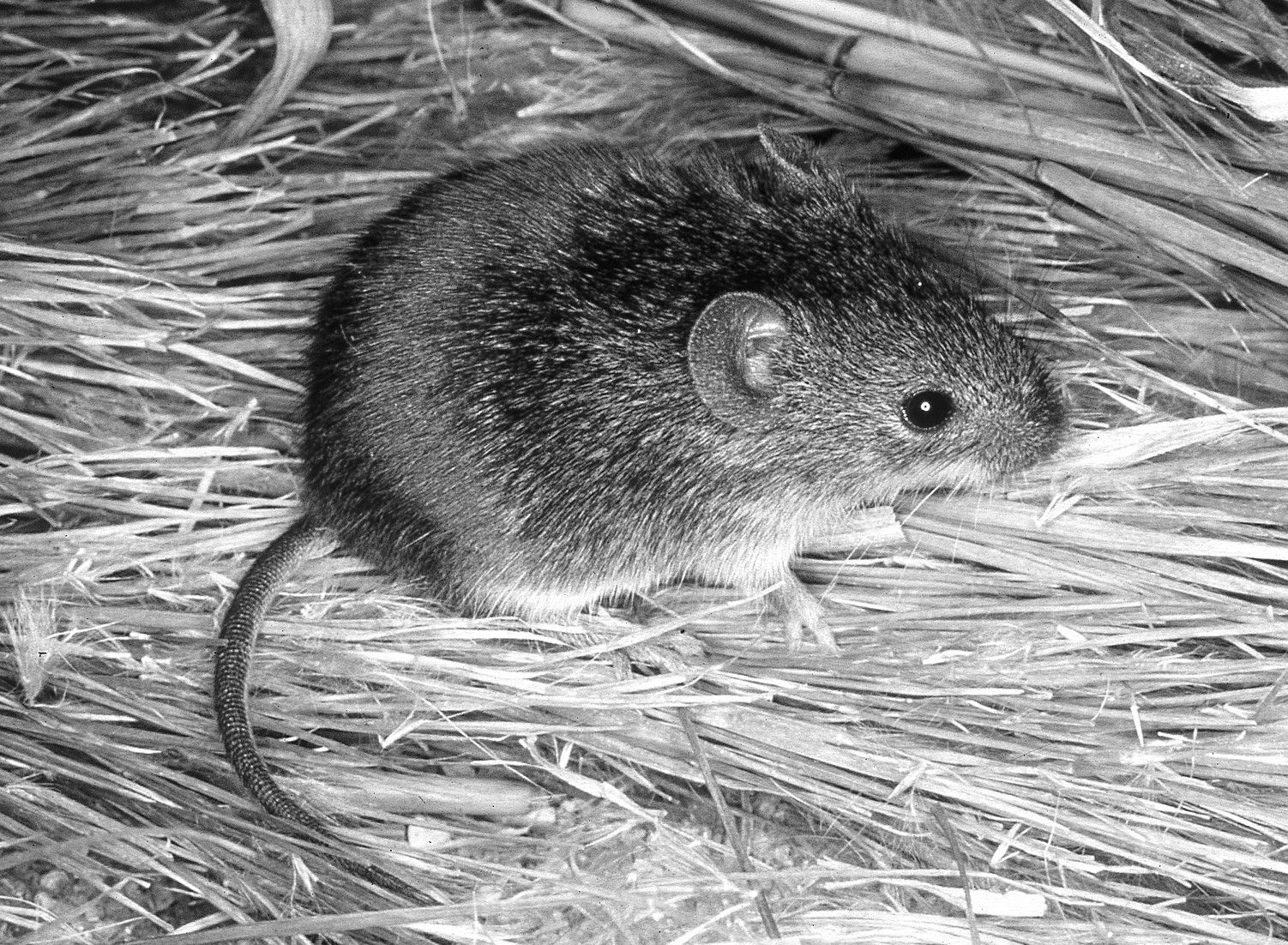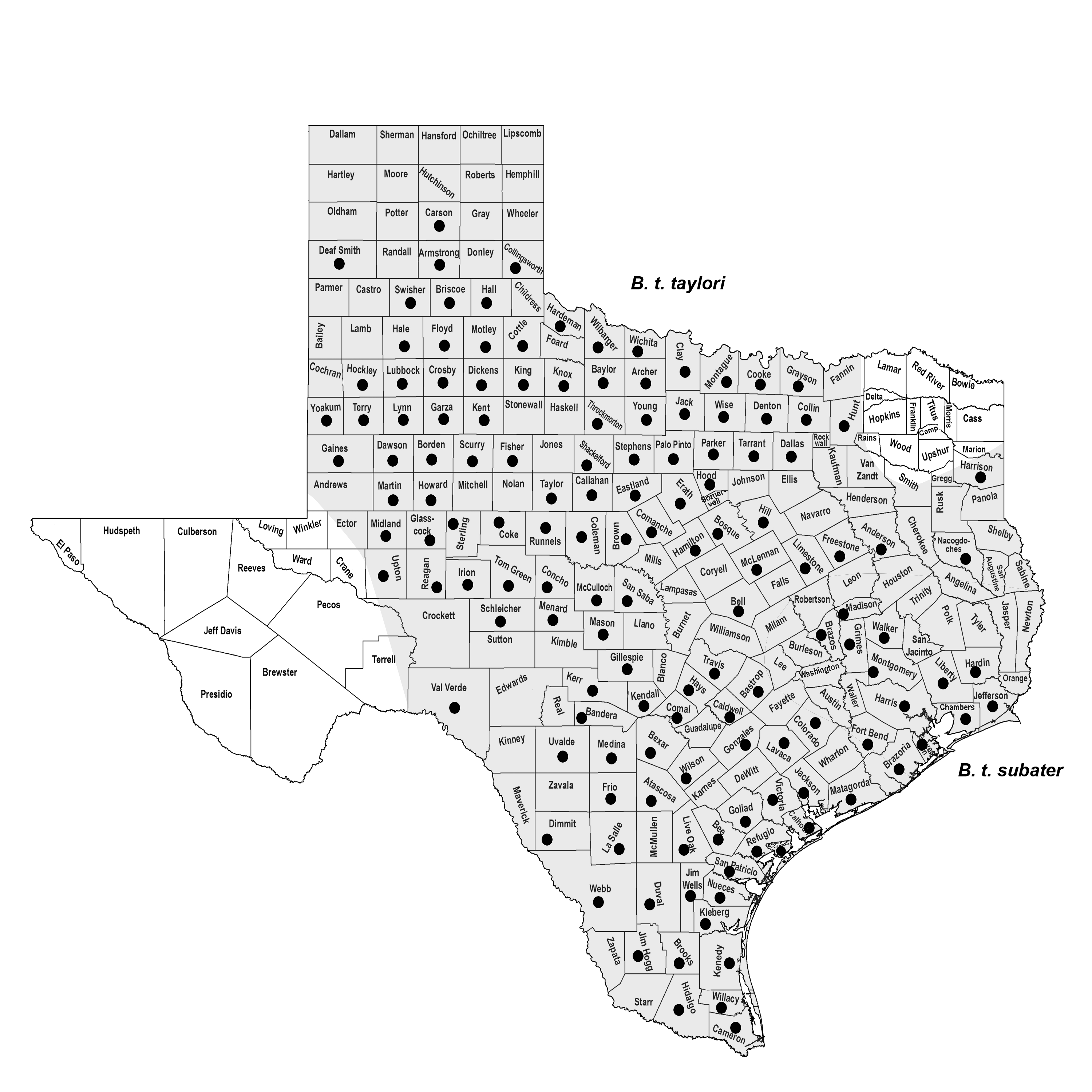NORTHERN PYGMY MOUSE
Baiomys taylori (Thomas 1887)
Order Rodentia : Family Cricetidae
DESCRIPTION. Smallest of the cricetid mice in Texas, with the exception of two harvest mice, Reithrodontomys humulis and R. montanus, both of which differ in having grooved upper incisors and longer tails. Upperparts grizzled grayish in adults, blackish in juveniles; underparts smoke gray; tail about three times as long as hind foot, sparsely haired, and decidedly shorter than head and body. They have a strong, musky odor similar to that of house mice, Mus musculus. Dental formula: I 1/1, C 0/0, Pm 0/0, M 3/3 × 2 = 16. Averages for external measurements: total length, 98 mm; tail, 38 mm; hind foot, 14.5 mm. Weight, 7–10 g, averaging 8 g.

DISTRIBUTION. Distributed over much of the state; range excludes the Trans-Pecos and the extreme northeastern parts of the state.

SUBSPECIES. Baiomys t. taylori over most of the range in Texas and B. t. subater in the southeast.
HABITS. This is a southern species characteristic of the tropical lowlands of Mexico that reaches its northern distributional limits in Texas. Early records indicate that B. taylori was restricted to the coastal region of eastern Texas and the mesquite–chaparral regions of southern Texas. Since the early twentieth century the species has consistently extended its range northward and eastward by invading the oak–hickory association, the Blackland Prairies, the Cross Timbers, the Rolling Plains, and the High Plains.
These mice have a preference for grassy areas, including weedy and overgrown habitats, and they are commonly found in old fields, pastures, and along railroad and highway right-of-ways, where they usually live in dense habitat in close association with hispid cotton rats (Sigmodon hispidus) and harvest mice (Reithrodontomys spp.). If other types of ground cover, such as rocks, cactus, and fallen logs, are available, the northern pygmy mouse may be found in areas where grass is relatively sparse. On the Llano Estacado, B. taylori inhabits thick grassy–weedy habitats along fencerows, highway and railroad right-of-ways, and occasionally upland pastures—mostly places with dense grassy vegetation.
Pygmy mice live in nests placed in burrows in the ground, beneath fallen logs, among cactus pads, or in thick clumps of grass. The nest is typically a ball of finely shredded grass or cactus fibers with a central cavity and one or two openings. A network of runways or beaten paths leads away from the nest sites beneath a thick mat of dead grass. These travel routes resemble those made by cotton rats and voles but are smaller in size.
Their diet is mostly herbivorous and granivorous, but animal matter is consumed if available. Stems and fruits of prickly pear, seeds and leaves of grasses, mesquite beans, insects, terrestrial snails, and small reptiles are included in the diet. They are active year-round and do not hibernate; neither do they store food for winter use. Although they are chiefly nocturnal, they have been caught in traps on several occasions in the daytime. They can swim well when necessary, but water is avoided whenever possible because their short fur is easily water-soaked.
The breeding season is nearly yearlong, with peaks in the late fall and early spring months. On the Llano Estacado, reproductive activity is limited to the warmer months. In captivity, one female gave birth to nine litters in 195 days; another individual had eight litters in 221 days. The gestation period is about 20 days. The litters vary in size from one to five, averaging about three. At birth, the young are naked, blind, and helpless and weigh about 1 g each. The eyes open in 12–15 days, the mice are weaned in 18–22 days, and sexual maturity is attained at the age of about 60 days. In captivity, both male and female pygmy mice care for the offspring.
POPULATION STATUS. Common. This little mouse has increased its range over much of Texas during the twentieth century. The development of railroad and highway right-of-ways has facilitated the northern pygmy mouse's geographic expansion, as has restoration of native grasslands through the Conservation Reserve Program.
CONSERVATION STATUS. The IUCN lists the northern pygmy mouse as a species of least concern, and it does not appear on the federal or state lists of concerned species. This species is in good shape.
From The Mammals of Texas, Seventh Edition by David J. Schmidly and Robert D. Bradley, copyright © 1994, 2004, 2016. Courtesy of the University of Texas Press.
Natural Science Research Laboratory
-
Address
Museum of Texas Tech University, 3301 4th street, Lubbock, TX 79409 -
Phone
806.742.2486 -
Email
nsrl.museum@ttu.edu

